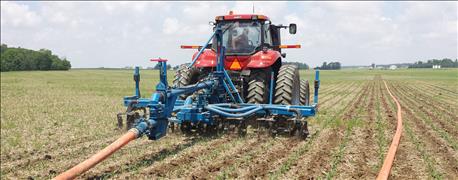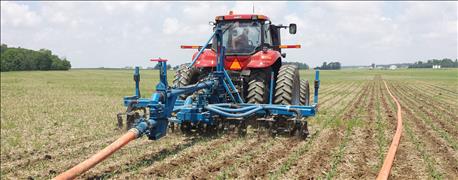
If you happen to take a springtime drive through rural Darke County, you’re likely to notice a few cornfields planted diagonally rather than square with the road. Planting at a 45-degree angle does require some extra effort, but the angled rows give the farmers an advantage when it comes time to sidedress the fields with manure, explains Sam Custer, the Ohio State University Extension ag educator in Darke County. He has been working with Darke County farmers Tom and Korey Harrod to study the use of liquid hog manure as sidedress fertilizer. The replicated test plots are showing a yield advantage to manure over commercial 28% UAN.

EXTRA BENEFIT: Applying manure as sidedress fertilizer rather than applying it in the fall after harvest gives farmers more benefit from the manure nutrients, according to OSU Extension research.
In addition to yield comparisons, the Harrods and Extension researchers are looking at application methods and timing to help farmers use their manure more effectively. Other area farmers are also experimenting with sidedress applications of liquid hog, dairy and beef manure.
Applying manure as sidedress fertilizer rather than applying it in the fall after harvest gives farmers more benefit from the manure nutrients, Custer says. When nutrients are applied just before the crop needs them, they are more likely to be taken up and used by the crop. In addition to using manure more efficiently as fertilizer, application during the growing season reduces environmental concerns from surface runoff of nutrients or loss of nutrients down through the soil profile and out through tile.
Sidedressing manure on corn also gives farmers and commercial manure applicators another application window. A dragline system can be used after planting until the corn reaches growth stage V3 without excessive crop damage, Custer explains. That opens an application window of about six weeks in late spring, which is a slow period for most commercial manure applicators, he notes. As farmers learn more about the practice, he expects more of them to get their own application toolbars and work with commercial applicators who supply pumps and hoses.
Modern machinery guidance systems make it easier to keep manure sidedress applications between the rows, Custer says. Using a diagonal planting pattern for the corn simplifies handling of the manure draglines and makes it possible to maneuver them using just one tractor. He recommends using draglines with toolbar systems to place the manure about 6 inches underground. Covering the manure reduces odor and the loss of nitrogen through volatilization, especially during warm weather, he explains.

Several years of plot data have shown that using dragline application equipment is preferable to using manure tankers for sidedress applications. “There’s too much weight hauling a manure tanker through the corn,” says Custer. Besides compaction, damage to the stand caused by traffic through the field is also a concern. In 2013, a tanker was used for Darke County plot tests and part of the corn was plowed out during application, reducing the stand. “We didn’t have a whole lot of luck that year,” Custer notes. Even so, the corn yields in the plots sidedressed with manure ended up being about the same as the corn sidedressed with commercial 28% UAN. The nitrogen application rate was the same for both sets of plots.
In 2014, a dragline system was used rather than a tanker, and part of the test plots were planted diagonally. They struggled to handle the draglines while minimizing crop damage on the plots with traditional planting alignment and found that the lines were easier to manage with diagonal planting. Yields that year were about the same for the manure sidedressed plots and those fertilized with 28% UAN.
The unusual rains in 2015 showed one of the advantages of nitrogen from manure over 28% UAN. “That was a big rain year; we had 10 inches of rain in June,” recalls Custer. The nitrogen in the manure seemed to remain in the soil longer, and the plots with manure yielded 32 bushels per acre more.
In 2016, they saw a little more damage to the crop from the draglines because the soil in the test field was mellow, says Custer. But even though they had trouble managing the hose in the mellow soil, the yields were still better for the manure plots.
To allow area farmers to assess manure sidedressing on their own farms, Ohio State Extension will be making a 12-row toolbar available for Darke County farmers to use on a few acres this year.
About the Author(s)
You May Also Like




